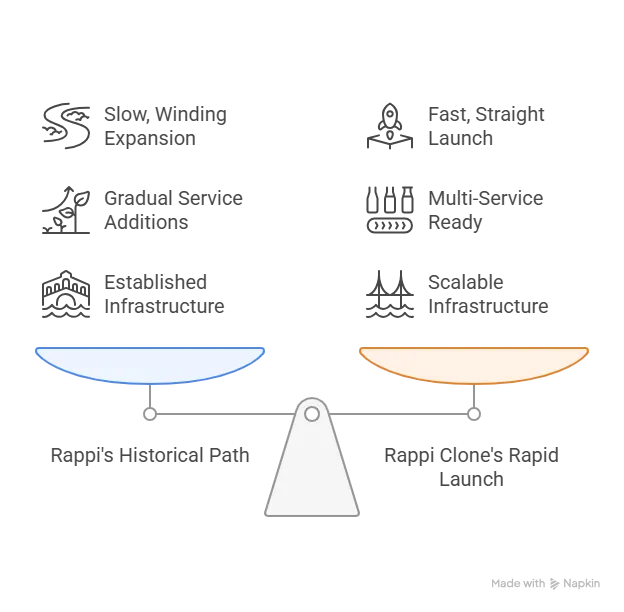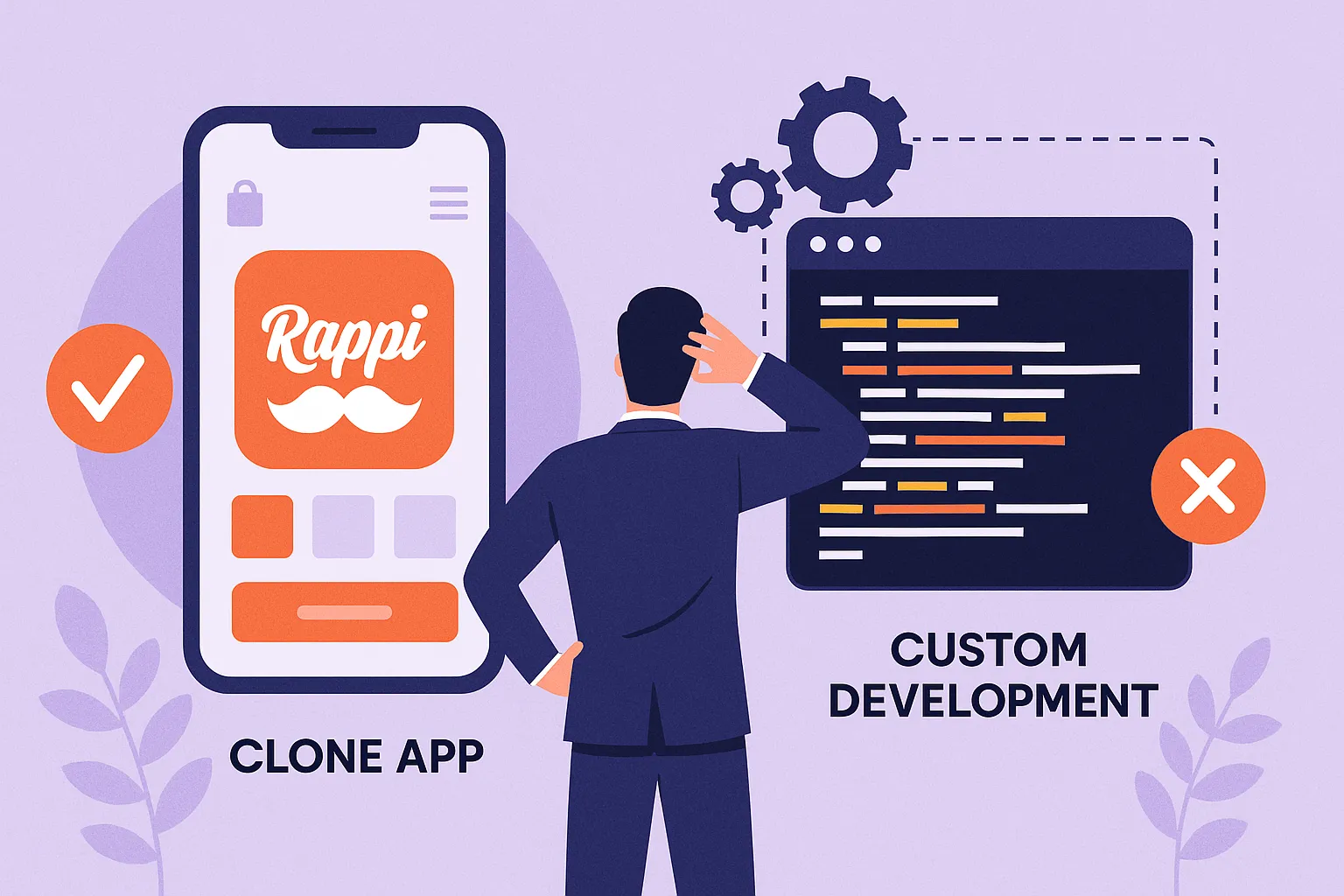Everyone loves a good David-versus-Goliath story—especially founders who stare at enormous “to-do” lists and shrinking burn-rates every morning. Rappi clone A decade ago, Colombian upstart Rappi crashed the party dominated by global giants and regional incumbents, turning the Spanish verb rappear (“to hustle”) into a lifestyle choice. If you’re building a delivery startup in 2025, you’d kill for that lightning-in-a-bottle momentum—but you probably don’t want to blow two years and a VC war-chest reinventing the same logistics plumbing Rappi already perfected.
I’ve been in a few late-night strategy huddles where someone slams the whiteboard and yells, “Let’s just clone the darn thing!” That knee-jerk can feel reckless—until you realize that 90-day launch windows beat 18-month rewrites, every single time. Today we’ll unpack why savvy founders skip custom dev and ride a Rappi Clone straight to product-market-fit (PMF) land.
Spoiler alert: Miracuves has helped more than 50 growth-stage teams do exactly that without drowning in code debt or ballooning costs. If you’re curious how, keep reading—because the same shortcut might save your runway, too.
What Exactly Is a Rappi Clone?
Think of it as a blueprint of the original Rappi app — including all the essential modules like:
- User App: For customers to browse, order, track deliveries, and pay.
- Delivery Partner App: For drivers to receive delivery requests, navigate, and manage tasks.
- Merchant/Vendor App: For restaurants, grocery stores, or pharmacies to manage listings and orders.
- Admin Panel: A central dashboard to oversee and manage the platform (users, orders, payments, etc.)
The clone is white-label, which means you can rebrand, customize features, and even change the UI/UX to match your niche or regional needs.
How Does It Work?
Here’s a simplified flow of how the Rappi Clone functions in real-world usage:
- User Registration/Login
Users sign up using email, phone, or social accounts. - Browse & Order
They browse nearby restaurants, stores, or services based on GPS location and place an order. - Real-Time Tracking
The user can track the delivery agent’s movement on the map after order confirmation. - Payment & Reviews
Payments can be made via cards, wallets, or COD (if enabled). Users can also rate services post-delivery.
Read More : What is Rappi App and How Does It Work?
Market Timing: Catch the Quick-Commerce Wave, Don’t Chase It
Rappi’s co-founder recently hinted the company could file for an IPO within a year—while admitting they’re already profitable across nine countries. That’s your flashing neon sign: quick commerce in Latin America hasn’t peaked yet, but the window to join the leaderboard is closing fast.
Why a clone helps:
- A pre-built engine lets you soft-launch in weeks, capturing first-mover buzz in secondary cities Rappi hasn’t saturated.
- You can funnel savings into hyper-local partnerships—think bodegas, pharmacies, dark kitchens—rather than burning cash on ground-up architecture.

Cost Advantage: VC Dollars Belong in Growth, Not Re-Coding Basics
Breakdown of custom build costs (ballpark):
- Core logistics + route optimization: $250k–$400k
- Real-time driver tracking stack: $150k
- Customer-facing iOS/Android apps: $120k
- PCI-compliant payment gateway integration: $70k
- Ongoing maintenance (year 1): 20–30 % of dev budget
A Miracuves clone collapses that spend by 60-70 %, freeing capital for promo codes, free-delivery sprints, and city-by-city influencer blitzes.
Read More : Best Rappi Clone Scripts in 2025: Features & Pricing Compared
Data-Driven Growth Loops—No Guesswork Required
Sensor Tower’s August 2024 report shows Rappi dominating mobile MAUs in Colombia while duking it out with PedidosYa in Argentina. The takeaway? In LatAm, acquisition cost is ruthless; retention is the kingmaker.
Miracuves’ clone ships with:
- Cohort analytics dashboard (mixpanel-style)
- Predictive churn alerts
- Coupon A/B testing harness
Translation: You tweak promos based on live funnel data, not gut feels.
Total Ownership, Zero “Vendor Lock-In” Anxiety
Yes, clone = template, but the codebase is 100 % yours. Want to bolt on drone deliveries or an AI-powered componer (recommendation engine)? Fork it. Miracuves delivers clean, commented code—minus messy third-party shackles.
Storytime: A Peruvian founder customized our Rappi clone to integrate electric scooter fleets, slashing last-mile costs 18 %. He calls it “Rappi con ruedas verdes.” That mod shipped in four sprints because he wasn’t reverse-engineering proprietary SDKs.
Brand, Not Backend, Becomes Your Moat
Consumers remember quirky mascot llamas, witty push copy, and lightning-fast refunds—not which queue system you deployed. A clone frees design and marketing to craft those sticky brand moments:
- Haha micro-copy when drivers hit traffic (“Our rider’s stuck behind a telenovela-worthy jam. Hang tight!”)
- AR filters that paste hot-sauce halos over delivered tacos
- Local holiday promo badges (¡Feliz Día del Niño!)
Spend time making hearts race, not debugging WebSocket handshakes.
Conclusion :
Speed wins markets, and clones are the fastest vehicle in town. When your competitors are still story-pointing basic delivery flows, you’ll be courting restaurants, refining retention loops, and plotting fresh revenue frontiers.
At Miracuves, we help innovators launch high-performance app clones that are fast, scalable, and monetization-ready. Ready to turn your idea into reality? Let’s build together.
FAQs
How customizable is a clone?
Think Lego, not super-glue. You can reskin, add modules, or even rewrite entire services without breaking the foundation.
Will investors frown on “clone tech”?
VCs fund risk-adjusted growth. If a clone shrinks time-to-revenue, most investors applaud the pragmatism—and ask how fast you’ll scale.
What about unique features Rappi doesn’t have?
A solid clone surfaces clean APIs, so layering innovations—voice ordering, drone drops, BNPL—is straightforward.
Is compliance really “set-and-forget”?
Regulations shift, but the base passes current PCI-DSS and GDPR audits. Miracuves ships update patches whenever rules change—no extra dev sprint needed.
How do clones affect ongoing maintenance costs?
Shared, battle-tested code reduces bug-hunt hours. Clients report 30–40 % lower monthly DevOps spend versus scratch-built stacks.
Can I migrate off the clone later?
Absolutely. You own the repo. If you outgrow it, treat the clone as MVP scaffolding and gradually refactor micro-services—at your pace, on your budget.








